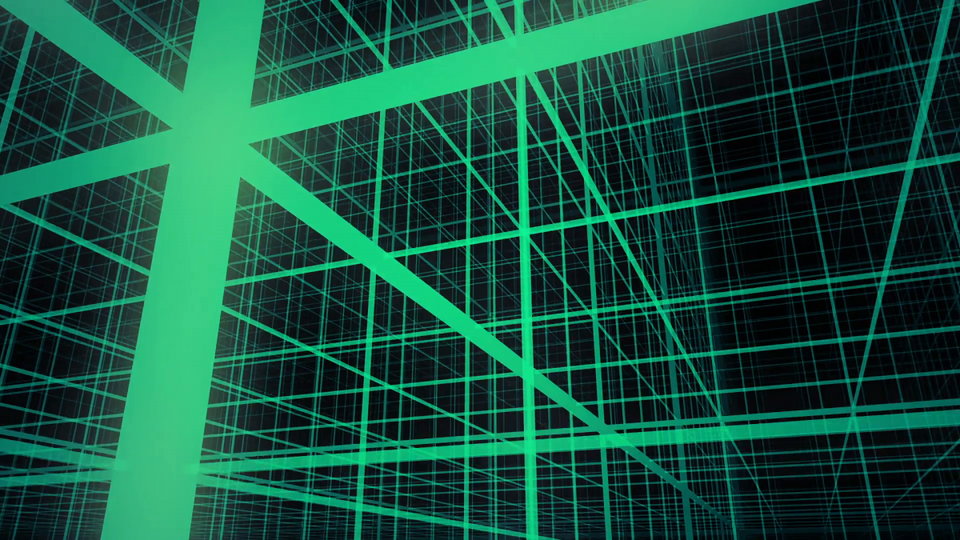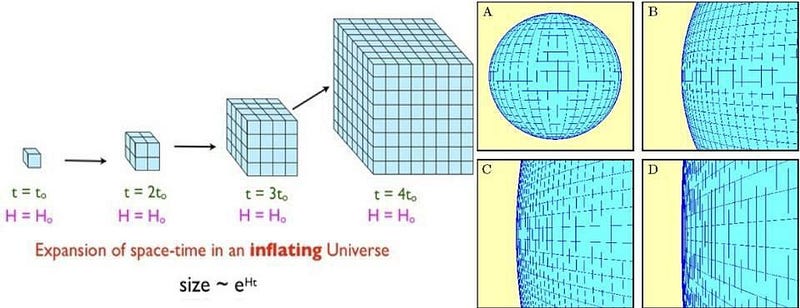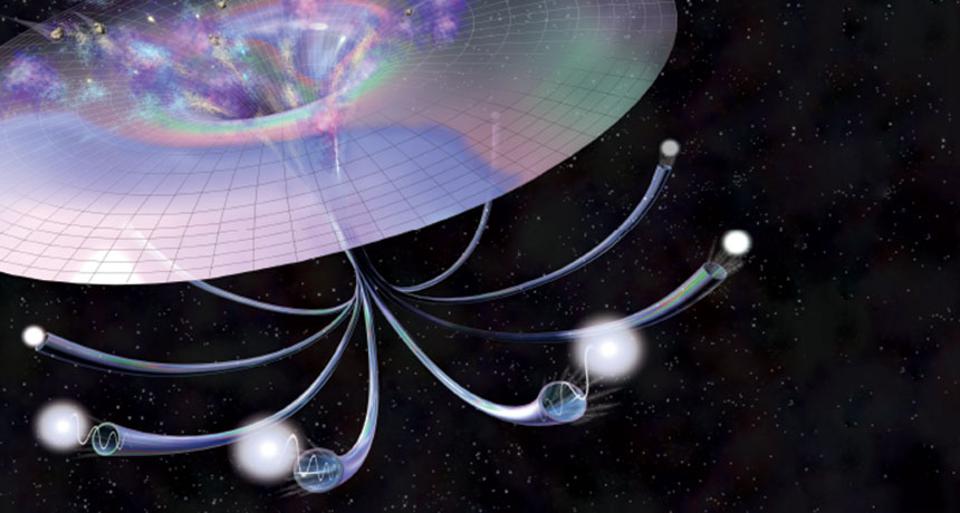What was it like when cosmic inflation occurred?

- The hot Big Bang occurred 13.8 billion years ago, but can no longer be identified as the “beginning” of space and time. Before it, a state of cosmic inflation occurred.
- Inflation solves a series of problems that otherwise have no explanation within the standard Big Bang framework, plus it’s made several new predictions that have since been borne out spectacularly by observation.
- In this article, the first part of a 31-part series, we break down what the Universe was like when cosmic inflation was occurring: a wildly alien and unfamiliar state.
Our Universe today is full of matter and radiation and can be observed by us through a variety of means. Atoms have clumped and clustered together due to billions of years of gravitation. This has formed a great cosmic web on the largest scales, with clusters of galaxies, individual galaxies, clouds of gas, stars, planets, and more on smaller scales. Through it all, the Universe has been expanding and cooling, something it’s been doing since the earliest moments of the hot Big Bang.
But the Big Bang wasn’t the very beginning of the Universe. Before that, there was a period known as cosmic inflation, which came earlier and set up the hot Big Bang. While living in an expanding, cooling Universe is difficult to intuit, inflation paints an entirely different picture. Here’s what it would be like to live in an inflating Universe.

Imagine that you were a particle, located somewhere in the fabric of spacetime. A short distance away, another particle also exists. Imagine that the only thing that impacts them is the expansion of the Universe. How, then, will this particle move relative to you?
- If your Universe were filled with radiation, it would expand like the square root of time: the distance between you and this particle scales as ~t½.
- If your Universe were filled with matter, it would expand like time to the two-thirds power: the distance between you and this particle scales as ~t⅔.
- But when your Universe inflates, space expands exponentially: like ~eHt, where H is the expansion rate of the Universe at any moment in time.
Whereas a radiation-filled or matter-filled Universe will dilute as it expands, causing the expansion rate to evolve by slowing down, the key feature of an inflating Universe is that its expansion is relentless: the expansion rate does not drop off with time.

This means that after a certain amount of time, this particle would double its distance from you. Because inflation is not only exponential but also rapid — the expansion rate is very large during inflation — that doubling only requires somewhere in the neighborhood of 10-35 seconds. But the defining trait of inflation isn’t its rapidity, since, after all, the early stages of the hot Big Bang may be just as rapid. Instead, the defining trait of inflation is its relentlessness.
- After 10-35 seconds, this nearby particle would be twice as far away as it initially was.
- After 2 × 10-35 seconds, it would be 4 times its initial distance.
- After 3 × 10-35 seconds, it would be 8 times its initial distance.
- After 4 × 10-35 seconds, it would be 16 times its initial distance.
And we can continue this as long as we want. After 10-34 seconds of inflation, the nearby particle would be 1024 times as far away (about 103 times) as it was initially. After 10-33 seconds, it would be 1030 times as far as its initial distance. And after a minuscule 10-30 seconds of inflation, this particle would be about 1030000 times as distant as it was initially. If your Universe began full of particles of any type, they would in extraordinarily short order be driven away from one another so that no two ever saw each other again.

Space itself may have begun with an interesting intrinsic curvature to it. It could have been balled-up, knotted, twisted-and-turned, or even spherical. It could have been full of topological defects, with holes throughout it. It could have been connected in multiple places in bizarre ways. It could have even contained the entirety of space within a volume as minuscule as a subatomic particle.
But during inflation, this rapid-and-relentless expansion will increase the size of the Universe many, many times over: by the same amount that it would push any other particle away. It will take any initial geometry and stretch it to such a large scale that any region you look at — even something as large as our entire observable Universe today — would be indistinguishable from spatially flat.

The reason inflation works this way is because there’s a large amount of energy that’s intrinsic to space itself. As the fabric of the Universe expands, new space gets created, also with that same amount of energy inherent to it. This is why the expansion is relentless. If you look at an inflating Universe, it continues to inflate in an ongoing fashion, never decreasing in its rapidity.
But on the very smallest scales, under these conditions, there’s also something occurring that cannot be ignored: quantum fluctuations in the underlying quantum fields that permeate all of reality.

These fluctuations happen in our Universe today, only they occur both on very low energy scales and on timescales that are extremely short compared to anything we observe. If you visualize these fluctuations as virtual particle-antiparticle pairs popping in-and-out of existence, they do so on timescales that are far too short to result in anything interesting happening; they simply add a small amount of extra energy to the fabric of space itself.
We know that today, in our modern Universe, we do have a positive, non-zero value to the overall “zero-point energy” of empty space; that can be equated with the dark energy we observe now. But in the early Universe, during inflation, the expansion rate was much, much greater than it is today: trillions upon trillions upon trillions of times greater, in fact.

During inflation, it’s not only the zero-point energy of space that was larger than it is today, but also the energy of the quantum fluctuations that occurred at that time. In fact, inflation’s quantum fluctuations are much, much larger in energy: about 100 orders of magnitude larger than they are today. On average, the value of the energy inherent to space jumps up-and-down by about 0.003% randomly, due to these quantum fluctuations.
Unlike today, though, those fluctuations don’t remain “localized” to one particular region of space where they occur. Back when the Universe was inflating, these fluctuations were getting stretched across the Universe: remaining imprinted onto the fabric of space, even as the fabric itself expands.
As a result, the value of the energy inherent to space varies from place-to-place, with the older, more-stretched fluctuations showing up on larger scales, and the younger, less-stretched ones appearing on smaller scales.

With every 10-33 to 10-32 seconds that passes during inflation, the smallest subatomic scale we can describe with our physical laws known today — the Planck scale — gets stretched to the size of our presently observable Universe and beyond. On longer timescales than that, any fluctuations that occurred previously then become unobservable: stretched to distance scales that are far in excess of the cosmic horizon.
Inflation, remember, isn’t just a rapid state of expansion, but also a relentless one. Whatever happened to occur just a tiny fraction of a second ago is now more than an entire visible Universe away. On all scales, from the very small to the very large, there should be these quantum fluctuations that are not only imprinted, but are continuously newly imprinting themselves, on the Universe.

Yet inflation doesn’t last forever everywhere in the Universe. Every time new space is created, there’s a small-but-finite probability that inflation will be brought closer to its inevitable end, with the same quantum fluctuations that imprint themselves on the Universe also serving to, at least in some places, bring inflation to an end.
One way to visualize whether inflation ends or not is to picture a ball that rolls very, very slowly atop a flat plateau. Below the plateau is a valley that lies below; if the ball rolls into the valley, inflation ends.
When you create new space, there’s again a random distribution of probabilities: whether the ball rolls closer to the plateau’s center or closer to the edge. For the places where the ball reaches the edge and rolls into the valley, inflation ends and the energy transforms into the energy of the hot Big Bang.

It was very likely that the first regions to undergo this transition weren’t the ones that became our observable Universe, but rather were pushed away by the much larger, more voluminous regions where inflation continued to persist. It’s very likely that we continued to inflate while these other “Big Bangs” occurred elsewhere in our inflating Universe.
Most of them were incredibly distant, but some of them may have occurred very close to the region that eventually became our Universe. As long as inflation goes on, space continues to be filled with these energy fluctuations on all scales, creating a fabric of space that appears like a continuously vibrating grid. This creates a picture, if we choose to visualize it this way, where space is an eternally inflating ocean, containing small “pockets” within it where inflation spontaneously comes to an end, giving rise to a (much more slowly expanding) region where a Big Bang occurs. No two “pocket” Big Bangs ever collide, however, as the inflating regions between them continue to expand more rapidly than any of the regions where Big Bangs occur.

Finally, inflation comes to an end where we are. It’s as though all of this energy inherent to space, with slightly different values at different locations, all comes tumbling down. It transforms into matter, antimatter, and radiation, and creates a Universe that is now hot, dense, and uniform in temperature, rather than cold and empty. If you go back to the “plateau and valley” analogy, the ball rolling down into the valley, and oscillating at the bottom of it, is what ends inflation and begins the hot Big Bang state.
This transition is known as cosmic reheating, and it marks the transition from an inflationary spacetime into the beginning of our hot Big Bang. The energy fluctuations become density fluctuations, which gives rise to the large-scale structure in our Universe today.
When inflation comes to an end, that’s when the Universe we know and recognize, the one that starts with a hot Big Bang, truly begins.

In theory, what lies beyond the observable Universe will forever remain unobservable to us, but there are very likely large regions of space that are still inflating even today. Once your Universe begins inflating, it’s very difficult to get it to stop everywhere. For every location where it comes to an end, there’s a new, equal-or-larger-sized location getting created as the inflating regions continue to grow. Even though most regions will see inflation end after just a tiny fraction of a second, there’s enough new space getting created that inflation should be eternal to the future.
Inflation set up and created the entire observable Universe, and gave the hot Big Bang the conditions it needs to have to be consistent with what we observe. But the inflationary Universe was dramatically different than the Universe we observe today. In order to understand and visualize it, we have to put our intuition aside, and embrace a reality where the only energy that matters is the energy intrinsic to the fabric of space itself.
This is part 1 of a 31 part series on “what was it like when…” taking us from before the Big Bang all the way up through the present day.


































